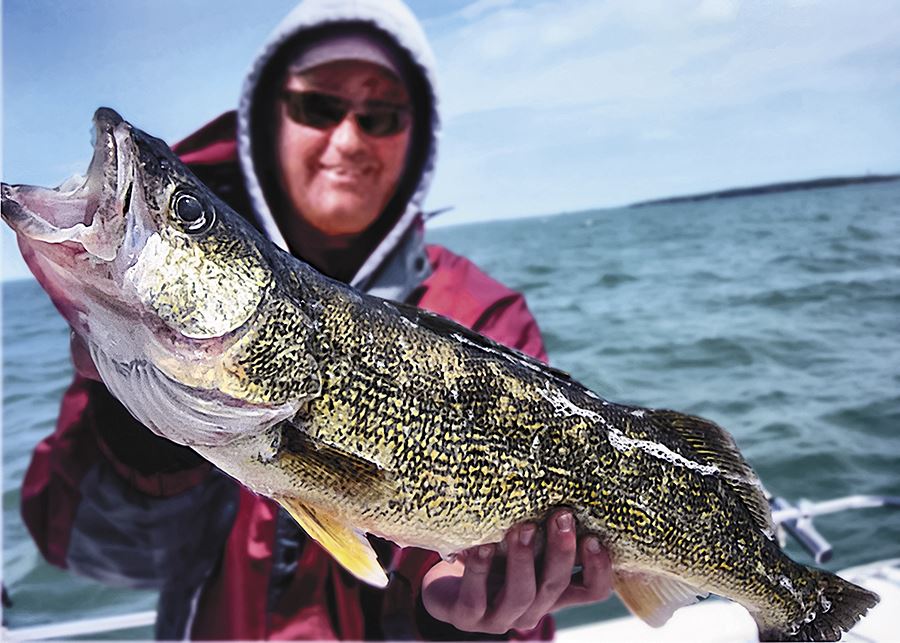.jpg_1600.jpg)
Some of the best action on big Great Lakes walleye takes place each autumn when the fish make a move back toward their spring spawning grounds. Many of the walleyes in lakes such as Erie that spawned in tributaries and atop reefs in the spring move east to deeper central basin waters for the summer, following forage fish that seek cooler conditions. Dropping temperatures in the fall trigger a similar move back west, following and feeding upon the baitfish, to eventually stage off the rivers and reefs for the winter, awaiting the annual spring ritual.
The same seasonal movements take place in walleye waters across the Great Lakes. When the walleye are on the move each autumn, they often come shallow, following the shoreline, which the predators use to block schools of shiners, shad, ciscoes, smelt and other baitfish to concentrate the forage and make them easier targets. That’s especially true during lowlight periods early and late in the day, when walleye have the upper hand thanks to their namesake “opaque” eyes, which allow the predators to see their prey in the darkest conditions. The "eyeshine" is the result of a light-gathering layer in the eyes called the tapetum lucidum, which allows them to see well in turbid waters as well as in low light.
This time of year, Great Lakes walleye put that special sight feature to full advantage, as they push schools of baitfish toward shore, pinning minnows against rocky shorelines, piers or beaches and picking them off from below.
While these fall feeding habits famously put the walleye in range of shore casters, boaters have even more options for action, not being limited to areas offering shore access. Slowly trolling shallow-diving, minnow-imitating crankbaits that match the size and shape of the primary forage, or anchoring and casting those types of lures along shorelines that host the autumn night-bite, are popular tactics for hooking late-season walleyes across much of their Great Lakes range.
Often, the move occurs in bays off the open water of the Great Lakes, which make for safer, more comfortable boating. This is especially important because the best autumn bites take place at times of lowlight and at night — or in really nasty weather during the day.
To find the active walleyes, scout at lower speeds or troll across the basins of bays, searching with electronics for sign of suspended fish or the forage they follow. Once the fish and or bait are located, troll with minnow-imitating crankbaits, attaching snap weights to the lines ahead of the lures if needed to reach the right depth. To fish multiple lines, use in-line planer boards to spread the lines and lures off to the sides of the boat. Walleye that shy away from the approach of the boat will move right into range of the baits behind the boards.
Whether casting, trolling flatlines or using boards, try your luck at late-season walleye this fall, and you just might find that you’ve been putting the boat to bed too early in seasons past.
.jpg_1600.jpg)
Working Autumn Weeds
An overlooked fall walleye tactic is trolling above weedbeds at night, when the fish may switch from suspending or holding near structure to cruise through shallow weedbeds to seek minnows. To intercept these active fish, look for shoreline flats and shelves that still hold beds of cabbage and then troll crankbaits mimicking the size and shape of the forage fish back and forth over the weeds. Walleye will often cruise deeper weed edges in the mornings and evenings, following baitfish doing the same.
In the absence of weeds, shallow rock reefs, riprap along dam faces and causeways, breakwaters, wood pilings and the like offer options to vegetation worth trolling over this time of year, especially if they are near deep water where the walleye may hang out during the day, then move over to feed as light diminishes. You can also work your boat close using an electric motor and cast to such structure to hook up with active autumn walleye.

Guide Spotlight
Captain Lee highlights Captain Cahlik
Captain Mark Cahlik of Port Clinton, Ohio, is a veteran at intercepting Great Lakes walleye during the fall migration on Lake Erie. Cahlik and his crew run several charter boats that specialize in low-light fishing this time of year, and he offers excellent full-service, condo-style quarters for his anglers on-site to boot.
For More Information:
Mark 1 Sport Fishing
www.mark1sportfishing.com
(419) 656-5060

